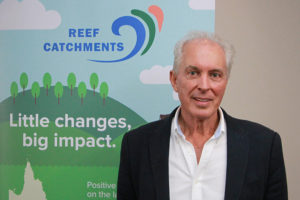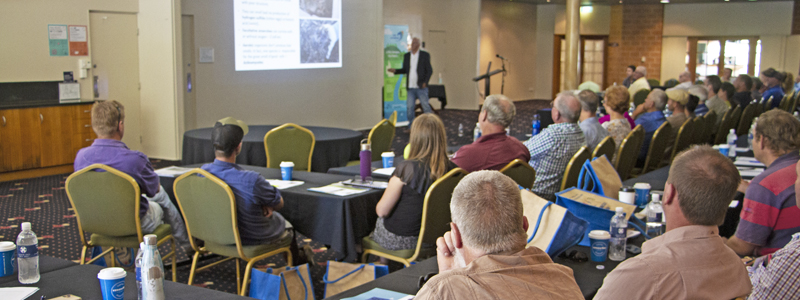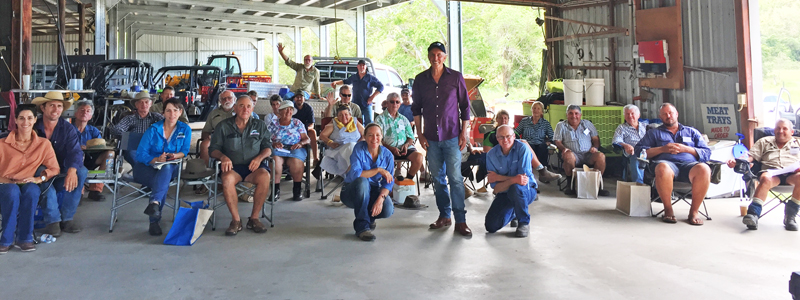At Reef Catchments every year ends with the Healthy Soils Symposium where presenters share their insights on Regenerative Agriculture and help the 80 plus strong crowd to explore the complex world of soil biology – chemistry and physics.
Regional Agriculture Landcare Facilitator, Juliane Kasiske, said Graeme Sait was mind blowing at the 2020 Healthy Soils Symposium and at the follow-up field day at Freckle Farm

Graeme delved into complex topics. Some of them were familiar to the crowd and while others were quite challenging and eye opening. Topics included the Soil Food Web, managing microbes, exploring the potential of humic and fulvic acid as a regenerative tool to replace chemical intervention and improve soil health, while explaining the interplay and core concepts of soil minerals to drive farm productivity.
On the day, local grazing and cane examples were explained and a regional perspective on the vast scale of streambank erosion and cost-effective management options were shared. The Symposium ended with a documentary ‘Kiss the Ground’ (available on Netflix) which summarised the topics of the day and provided a global perspective on issues of desertification, climate change, and the degradation of our food systems while highlighting the huge potential agriculture has as the solution through the power of plants and the power of people and communities.
Here is a collection of Resources including videos and pdfs

At the follow-up field day at Freckle Farm, Graeme attracted 35 participants. He emphasised that success in regenerative farming is knowledge-driven not input- driven. The conventional approach simplifies the complex, interrelated system. To become master of your trade, that system needs to be understood, said Grame Sait.
Revolution of Regenerative Agriculture
1) Annually we are losing 7 -12t/ ha globally. In fact, 1/3rd of our global soil has been lost since the industrial revolution and it is predicted that in 60 years’ time, we will have lost our precious top soil on which we are growing our food on
2) Regenerative Agriculture is about healing what was damaged. When soil is damaged its natural water and carbon cycles are destroyed, resulting in desertification.
3) Regenerative Agriculture and its soil building potential is recognised as a solution to curb climate change
4) The chemical residues found on our food and in our water highlights the need to embrace regenerative practices.
5) The increasing use of chemical inputs such as weed, and insect killers has resulted in pest and disease pressures becoming more of an issue. Besides pollination, insects’ function is that of garbage collectors. We need to grow healthy resilient crops and it starts with healthy soils rich in minerals and of high biological activity.

At the 2019 Healthy Soils Symposium, Guest speaker Dr Christine Jones, very visually explained the importance of microbes and their function in the soil, comparing them to a sophisticated civilisation of diverse microbes that connect, communicate, unlock and exchange vital information and resources.
Fungi is so incredibly important and yet is the most missing part in our soils!
In 2020, Graeme Sait shares ways of how the Fantastic Fungi can be protected. It serves as a cellulose digester creating humus. Minerals are made available and exchanged through fungi. They support plant immunity and play a key role in communicating and connecting across the vast and diverse microbial network underneath our feed.
How to protect your cheapest and most effective workforce:
1) Apply minimal till
2) Reduce salt fertiliser, or buffer the burn with some molasses or humic acid
3) Avoid fungicide treated seed
4) Replace long bare fallows with a cocktail cover crop consisting predominantly of grasses, legumes, and cereals, and some brassicas and chenopods
5) Avoid pesticides such as glyphosate
6) Embrace compost and bring back worms
7) Do not burn as it depletes the soil of microbes and minerals
8) Break compaction by paying attention to your C:M ratio and by embracing ground cover to oxygenate your workforce and allow water infiltration
9) Support stubble digestion with molasses
10) Expand your knowledge of Regenerative Agriculture and its many tools